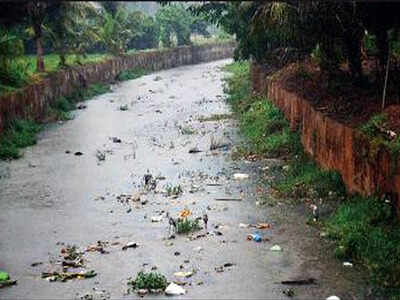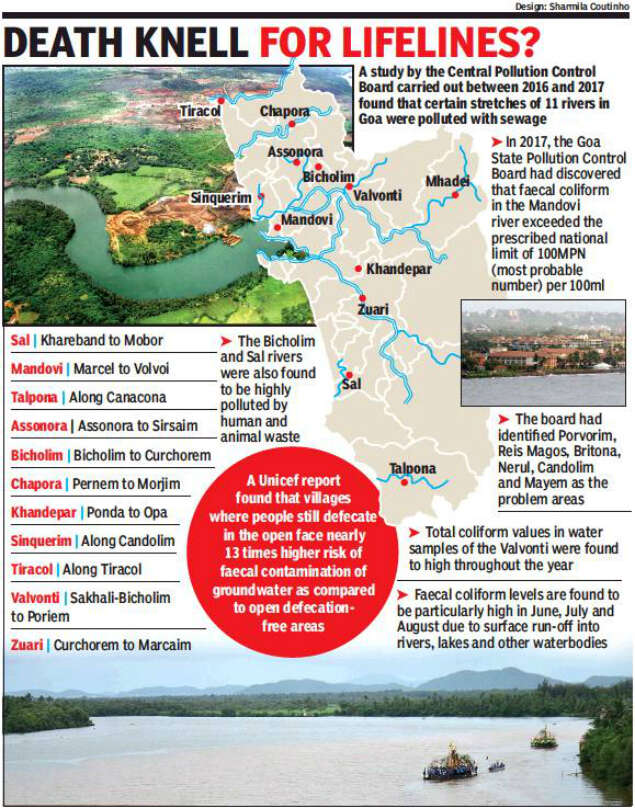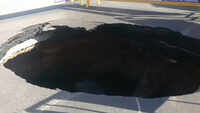
PANAJI: As several parts of Goa suffered a shortage of drinking water this summer, a major threat to raw water and groundwater sources e-coli contamination has largely gone unaddressed by the authorities. This is despite consecutive studies since 2014 by the Goa State Pollution Control Board (GSPCB) and the central authority confirming sewage contamination of stretches in all major rivers of Goa, including the Mandovi and the Zuari.

In Ponda, for instance, the Khadpabandh nullah was a freshwater stream until some years ago.
Originating in Bethora, it has now been reduced to nothing more than a foul-smelling drain. At Agapur, near the Durbhat jetty, the stream meets the Zuari.
Besides carrying contaminated water to the Zuari, the Khadpabandh stream threatens to pollute groundwater in the downstream areas of Ramnathi, Kavlem and Agapur. Villagers in these areas still depend on wells for drinking water.
State-run sewage treatment plants are not available at most areas in the state. In Ponda, the project is still in nascent stages.
Each tanker that clears septic tanks has a capacity to suck in 8,000-9,000 litres of sewage.
Goa’s rising population means that several septic tanks need clearing each day, but there are far too few facilities to deal with the thousands of litres of waste being generated each day.
Also, Goa is not yet open defecation-free and in many areas, waterbodies continue to be used a toilets.
“Regulations for residential complexes to compulsorily have sewage treatment plants are not being strictly enforced. Plants at several such complexes are constructed just as an eyewash. When septic tanks get full, private operators are called to clear them. These tankers clandestinely empty the waste in streams like the Khadpabandh nullah because it costs them more to go all the way to the sewage treatment plants in either Panaji or Margao. As the quantities of waste dumped increases, contaminants will eventually percolate to the groundwater table,” a Ponda resident said.
Merely making Goa open defecation-free is not enough, the citizen said while highlighting the need for a parallel effort to make sewage treatment a priority if streams and rivers were to be saved.
In Calangute, residents claim that a high density of sprawling hotels has already led to contamination of private wells in the vicinity.
“Many villagers used well water for drinking purposes until recently due to contamination. There are too many large hotels that are located in proximity to one another. We are hoping that once the sewage treatment plant for Calangute is made operational, the quality of our well water will improve,” Calangute resident Gabriel Fernandes, said.
N Y Nadkarni, who runs a waste water treatment consultancy, said e-coli contamination is the most difficult to deal with. “It cannot be destroyed easily and therefore, prevention is important. Operation of sewage treatment plants in private projects involves costs and many may not want to pay for it. It is, however, a necessity if we want to keep our groundwater safe in the long run. Letting sewage into streams and rivers will affect groundwater eventually,” he said.
Besides making sewage treatment plants operational in all major areas of Goa and strictly enforcing the use of waste treatment facilities at all major private projects, the state also needs to create awareness on reuse of treated water from sewage plants.
Currently less than 5% of the water derived from treating sewage goes unused in Goa.
“Also, in areas like Porvorim, we are facing problems to find land for a sewage treatment plant because residents feel they will have to bear the stench, which is not the case,” an official said. Citizens, on their part, have become wary of state-run facilities because of problems in the implementation of various projects.

In Ponda, for instance, the Khadpabandh nullah was a freshwater stream until some years ago.
Originating in Bethora, it has now been reduced to nothing more than a foul-smelling drain. At Agapur, near the Durbhat jetty, the stream meets the Zuari.
Besides carrying contaminated water to the Zuari, the Khadpabandh stream threatens to pollute groundwater in the downstream areas of Ramnathi, Kavlem and Agapur. Villagers in these areas still depend on wells for drinking water.
State-run sewage treatment plants are not available at most areas in the state. In Ponda, the project is still in nascent stages.
Each tanker that clears septic tanks has a capacity to suck in 8,000-9,000 litres of sewage.
Goa’s rising population means that several septic tanks need clearing each day, but there are far too few facilities to deal with the thousands of litres of waste being generated each day.
Also, Goa is not yet open defecation-free and in many areas, waterbodies continue to be used a toilets.
“Regulations for residential complexes to compulsorily have sewage treatment plants are not being strictly enforced. Plants at several such complexes are constructed just as an eyewash. When septic tanks get full, private operators are called to clear them. These tankers clandestinely empty the waste in streams like the Khadpabandh nullah because it costs them more to go all the way to the sewage treatment plants in either Panaji or Margao. As the quantities of waste dumped increases, contaminants will eventually percolate to the groundwater table,” a Ponda resident said.
Merely making Goa open defecation-free is not enough, the citizen said while highlighting the need for a parallel effort to make sewage treatment a priority if streams and rivers were to be saved.
In Calangute, residents claim that a high density of sprawling hotels has already led to contamination of private wells in the vicinity.
“Many villagers used well water for drinking purposes until recently due to contamination. There are too many large hotels that are located in proximity to one another. We are hoping that once the sewage treatment plant for Calangute is made operational, the quality of our well water will improve,” Calangute resident Gabriel Fernandes, said.
N Y Nadkarni, who runs a waste water treatment consultancy, said e-coli contamination is the most difficult to deal with. “It cannot be destroyed easily and therefore, prevention is important. Operation of sewage treatment plants in private projects involves costs and many may not want to pay for it. It is, however, a necessity if we want to keep our groundwater safe in the long run. Letting sewage into streams and rivers will affect groundwater eventually,” he said.
Besides making sewage treatment plants operational in all major areas of Goa and strictly enforcing the use of waste treatment facilities at all major private projects, the state also needs to create awareness on reuse of treated water from sewage plants.
Currently less than 5% of the water derived from treating sewage goes unused in Goa.
“Also, in areas like Porvorim, we are facing problems to find land for a sewage treatment plant because residents feel they will have to bear the stench, which is not the case,” an official said. Citizens, on their part, have become wary of state-run facilities because of problems in the implementation of various projects.
World Cup 2019
Trending Topics
LATEST VIDEOS
More from TOI
Navbharat Times
Featured Today in Travel
Quick Links
Lok Sabha Election Schedule 2019Lok Sabha Election NewsDelhi Capitals teamMI team 2019Rajasthan Royals 2019RCB team 2019Maharashtra Lok Sabha ConstituenciesBJP Candidate ListBJP List 2019 TamilnaduShiv Sena List 2019AP BJP List 2019Mamata BanerjeeBJP List 2019 MaharashtraPriyanka GandhiBJP List 2019 KarnatakaAMMK Candidate List 2019BJP List 2019 WBLok Sabha Elections in Tamil NaduBSP List 2019 UPNews in TamilLok Sabha Poll 2019Satta Matka 2018PM ModiMahagathbandhanNagpur BJP Candidate ListChandrababu NaiduTamil Nadu ElectionsUrmila MatondkarNews in TeluguMadras High CourtTejashwi YadavArvind KejriwalTejasvi SuryaPawan KalyanArvind KejriwalYogi AdityanathJaya PradaSatta King 2019Srinagar encounter
Get the app







